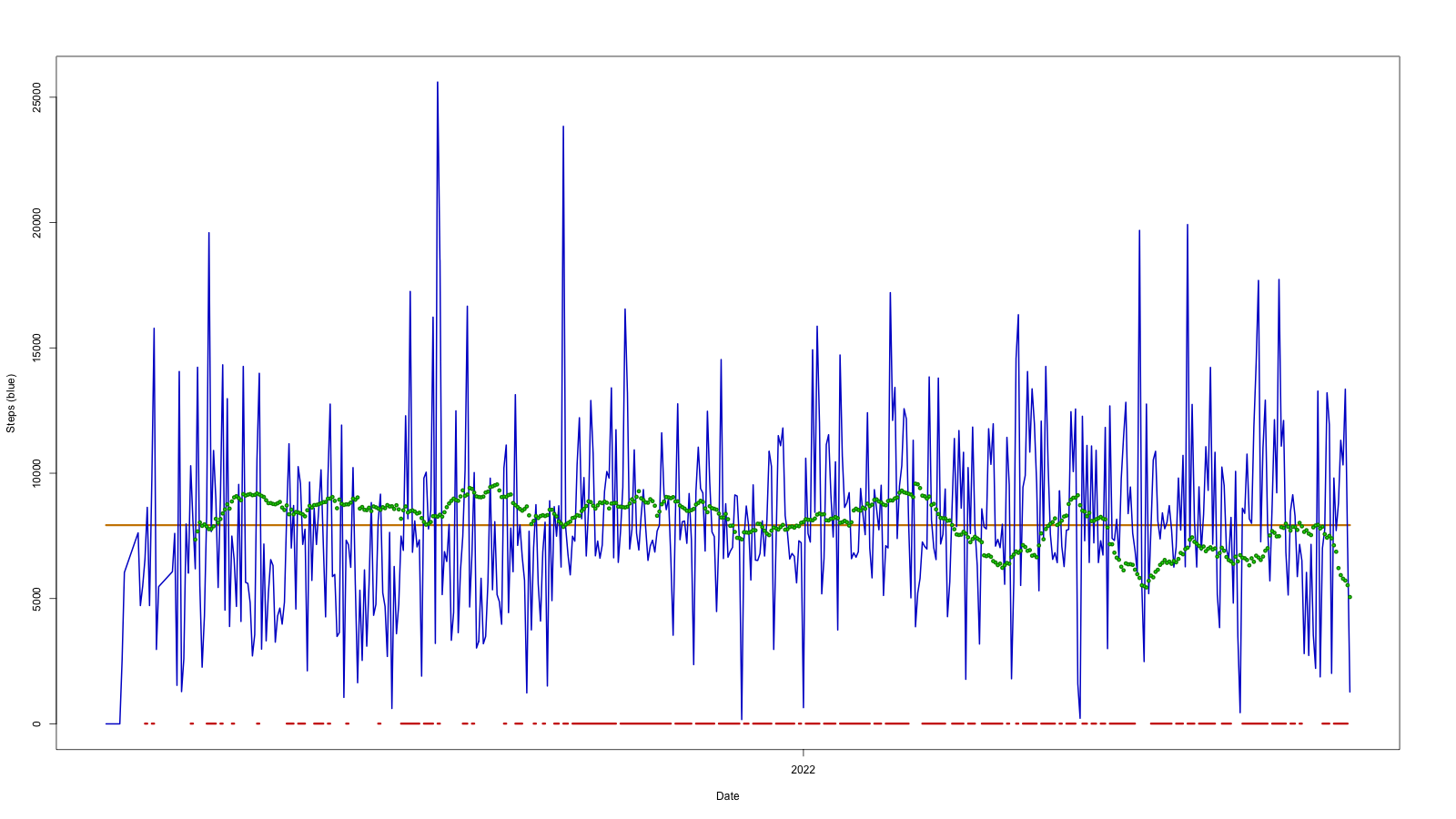In yet more at-home-data-science, I recently decided to take a look at my step count history and see what insights I could gain from visualizing the data. I've been using Pedometer++ to track my daily step count since 2014 and the app conveniently provides a CSV export of all of your daily step totals as well as other related data like distance and floors climbed. I think the results of my investigation are pretty interesting and yield some important insights.
First off, I simply plotted the entire data set to see what it showed. There were three things I noticed immediately.
-
Lossy Data:
You may notice that there are several holes in the data. This is because originally, I used Pedometer++ very infrequently. I didn't set a daily goal and I didn't open the app very often. This meant that — after a while — iOS stopped launching the app in the background to collect step data and at one point offloaded the app from my phone to free space. -
Two Very Tall Spikes:
I love seeing immediately identifiable trends in data, and those two spikes intrigued me. The first is my hike along a section of the PCT and the other is my trip to Barcelona and Paris in 2019. -
A Sudden Section of Stability:
This third section is probably the most interesting for our purposes here. During 2021 I decided to start taking my daily walks more seriously. I'd been going on at least one walk per day, but I finally decided to start setting a goal and trying to meet it every single day.
You may also notice the red lines at the bottom of the chart: these are any string of days during which I exceeded my goal (more on that soon). The brown line is the daily goal value itself.
Setting Attainable Goals
I've talked before about how I set arbitrary deadlines and goals for myself. Usually this is done for client projects or my own apps, but importantly it's a thing I do for personal goals too. In the post I wrote this:
I create artificial deadlines and goals, sometimes completely arbitrarily. Often times, I'll just pick a date on the calendar based on nothing but gut intuition, and then I change it later if necessary.
Back in 2021 I wanted to get more rigorous with my daily walks. I wanted to set a goal for myself and make sure I was meeting it as often as possible. This is important. Originally I had considered trying to meet the default in-app goal of 10,000 steps per day. This is a very common step goal for apps and services to suggest because it's a nice, big, round number. But I didn't do that. I went with a much more modest 6,000 steps as my goal.
The reason for this is simple. Like I said I wanted to meet this goal as often as possible — preferably every day. 10,000 steps is a lot to cram into a single day. I routinely surpass 10,000 but I am nowhere close to hitting it every day.
This goal-setting is important. Meeting a goal can be inspiring, but not meeting it is the opposite, and can be disincentivizing. With a goal too high it can be preferable to give up early rather than to try and fail. This runs counter to my goal: walk more. Giving up is bad, and so I wanted to minimize the amount of times I do it. 6,000 steps has been a good number for me because I routinely find myself around 1,000 steps short in the evening, which incentivizes me to go for a walk, which is what I want. And in a positive development, I ended up raising the goal in 2022 to 6,500 steps!
Additional Insights
What's perhaps most interesting to me is what happens when we zoom in on the 2021-2022 section of the data (after I set a daily step goal). Not only does the data become much more consistent because I checked the app daily, but it becomes incredibly regular. The 30-day rolling average (plotted in green) is very close to the daily goal, which implies that if we ignore the extreme days I'm pretty good at meeting my goals. The red streak line at the bottom also helps illustrate this.
I also notice that my rolling average is down this year which is something I wasn't expecting! If it continues like this I will be missing my goal regularly, which is bad. Insights like this have helped motivate me to improve and stay on top of my walking schedule.
If there's one thing I can share from this little experiment, it's this: set arbitrary goals, then celebrate once you've hit them.
Filed under:
Other Links: RSS Feed, JSON Feed, Newsletter, Status Page →


